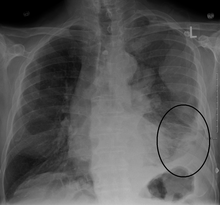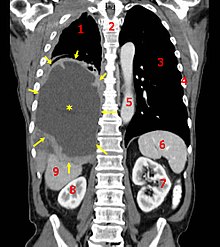Mesothelioma
Mesothelioma is a rare form of cancer that primarily affects the lining of the lungs. In less common cases, the heart and abdomen can also be affected by mesothelioma cancer. Approximately 2,000 to 3,000 cases of mesothelioma are diagnosed each year in the United States, comprising around 3 percent of all cancer diagnoses. This cancer occurs about four times more frequently in men than in women and all forms of mesothelioma, except for benign mesothelioma, are terminal since no cure has been discovered.The life expectancy for mesothelioma patients is generally reported as less than one year following diagnosis. However, a patient’s prognosis is affected by several factors, including how early the cancer is diagnosed and how aggressively it is treated.
In an effort to help patients understand mesothelioma, Asbestos.com offers a complimentary packet that contains treatment information tailored to your specific diagnosis. The packet also covers the nation's top mesothelioma doctors and cancer centers, as well as financial assistance options to help cover medical costs. To receive your packet in the mail, please enter your information below.
Symptoms of Mesothelioma
Signs and symptoms of mesothelioma vary depending on where the cancer occurs.Pleural mesothelioma, which affects the tissue that surrounds the lungs, causes signs and symptoms that may include:
- Chest pain under the rib cage
- Painful coughing
- Shortness of breath
- Unusual lumps of tissue under the skin on your chest
- Unexplained weight loss
- Abdominal pain
- Abdominal swelling
- Lumps of tissue in the abdomen
- Unexplained weight loss
Signs and symptoms of other types of mesothelioma are unclear. Other forms of mesothelioma are so rare that not much information is available. Pericardial mesothelioma, which affects tissue that surrounds the heart, can cause signs and symptoms such as breathing difficulty and chest pains. Mesothelioma of tunica vaginalis, which affects tissue surrounding the testicles, may be first detected as a mass on a testicle.

Who Gets Mesothelioma?
Statistics show that, because of their work history, the disease most often affects men between the ages of 50 and 70 who were employed in an asbestos-laden environment before asbesto regulations were imposed in the late 1970s. Though women still have a much lower frequency of the disease, cases of second-hand exposure to asbestos has prompted more diagnoses among women, especially those whose male family members worked with asbestos. The occupations most associated with mesothelioma are shipyard workers, electricians, plumbers, construction industry workers, pipefitters, boilermakers, and anyone subject to heavy exposure to dangerous airborne asbestos fibers.An abundance of cases have also shown us that mesothelioma can develop among people who lived in communities where asbestos factories or mines were located. In some instances, entire towns have been adversely affected by the presence of asbestos in the air. For example, in Libby, Montana - site of a former vermiculite asbestos mine - hundreds have already died of mesothelioma.
Though still significantly rarer than other cancers, an estimated 2,000 to 3,000 new cases of mesothelioma are diagnosed each year in the United States. Other countries, notably the United Kingdom and Australia, report a much higher incidence of the disease. Nevertheless, the United States - like many other countries - has seen an increase in asbestos-caused cancer as men who worked in U.S. shipyards in the 1940s and 1950s, at the height of production, are now being diagnosed with mesothelioma.
Causes of Mesothelioma
In general, cancer begins when a series of genetic mutations occur within a cell, causing the cell to grow and multiply out of control. It isn't clear what causes the initial genetic mutations that lead to mesothelioma, though researchers have identified factors that may increase the risk. It's likely that cancers form because of an interaction between many factors, such as inherited conditions, your environment, your health conditions and your lifestyle choices.Mesothelioma doesn't include a noncancerous tumor
A form of noncancerous (benign) tumor that can occur in the chest is sometimes called benign mesothelioma. However, this name is misleading. Benign mesothelioma doesn't begin in the same cells where the cancerous forms of mesothelioma begin. And, in a minority of cases, benign mesothelioma can be very aggressive, despite the term "benign." For this reason, some doctors now refer to this tumor as solitary fibrous tumor.
Solitary fibrous tumor usually doesn't cause signs and symptoms. Most cases are inadvertently discovered during tests and procedures for other conditions. It isn't clear what causes solitary fibrous tumors, but they aren't linked to asbestos exposure. Treatment for solitary fibrous tumor typically includes surgery.
Mesothelioma Symptoms
Symptoms of mesothelioma typically do not appear until 20 to 50 years after someone's initial exposure to asbestos occurred. Mesothelioma symptoms often resemble less-serious conditions, which can make a diagnosis difficult. Below is a list of several common symptoms mesothelioma patients may experience.Pleural Symptoms: Shortness of breath, chest pain, persistent cough, fatigue, lumps under the skin on the chest
Peritoneal Symptoms: Weight loss, abdominal pain and swelling, bowel obstruction, nausea
Pericardial Symptoms: Heart palpitations, irregular heartbeat, chest pain, difficulty breathing, night sweats
Testicular Symptoms: Painful or painless testicular lumps
Diagnosis of Mesothelioma




Generally, a biopsy is needed to confirm a diagnosis of malignant mesothelioma. A doctor removes a sample of tissue for examination under a microscope by a pathologist. A biopsy may be done in different ways, depending on where the abnormal area is located. If the cancer is in the chest, the doctor may perform a thoracoscopy. In this procedure, the doctor makes a small cut through the chest wall and puts a thin, lighted tube called a thoracoscope into the chest between two ribs. Thoracoscopy allows the doctor to look inside the chest and obtain tissue samples. Alternatively, the chest surgeon might directly open the chest (thoracotomy). If the cancer is in the abdomen, the doctor may perform a laparoscopy. To obtain tissue for examination, the doctor makes a small incision in the abdomen and inserts a special instrument into the abdominal cavity. If these procedures do not yield enough tissue, more extensive diagnostic surgery may be necessary.
Immunohistochemical studies play an important role for the pathologist in differentiating malignant mesothelioma from neoplastic mimics. There are numerous tests and panels available. No single test is perfect for distinguishing mesothelioma from carcinoma or even benign versus malignant.
| Positive | Negative |
| EMA (epithelial membrane antigen) in a membranous distribution | CEA (carcinoembryonic antigen) |
| WT1 (Wilms' tumour 1) | B72.3 |
| Calretinin | MOC-3 1 |
| Mesothelin-1 | CD15 |
| Cytokeratin 5/6 | Ber-EP4 |
| HBME-1 (human mesothelial cell 1) | TTF-1 (thyroid transcription factor-1) |
Staging of Mesothelioma
Staging of mesothelioma is based on the recommendation by the International Mesothelioma Interest Group.TNM classification of the primary tumor, lymph node involvement, and distant metastasis is performed. Mesothelioma is staged Ia–IV (one-A to four) based on the TNM status.Treatment of Mesothelioma
The prognosis for malignant mesothelioma remains disappointing, although there have been some modest improvements in prognosis from newer chemotherapies and multimodality treatments.Treatment of malignant mesothelioma at earlier stages has a better prognosis, but cures are exceedingly rare. Clinical behavior of the malignancy is affected by several factors including the continuous mesothelial surface of the pleural cavity which favors local metastasis via exfoliated cells, invasion to underlying tissue and other organs within the pleural cavity, and the extremely long latency period between asbestos exposure and development of the disease. The histological subtype and the patient's age and health status also help predict prognosis.Surgery
Surgery, by itself, has proved disappointing. In one large series, the median survival with surgery (including extrapleural pneumonectomy) was only 11.7 monthsHowever, research indicates varied success when used in combination with radiation and chemotherapy (Duke, 2008). (For more information on multimodality therapy with surgery, see below). A pleurectomy/decortication is the most common surgery, in which the lining of the chest is removed. Less common is an extrapleural pneumonectomy (EPP), in which the lung, lining of the inside of the chest, the hemi-diaphragm and the pericardium are removed.Radiation
For patients with localized disease, and who can tolerate a radical surgery, radiation is often given post-operatively as a consolidative treatment. The entire hemi-thorax is treated with radiation therapy, often given simultaneously with chemotherapy. This approach of using surgery followed by radiation with chemotherapy has been pioneered by the thoracic oncology team at Brigham & Women's Hospital in Boston. Delivering radiation and chemotherapy after a radical surgery has led to extended life expectancy in selected patient populations with some patients surviving more than 5 years. As part of a curative approach to mesothelioma, radiotherapy is also commonly applied to the sites of chest drain insertion, in order to prevent growth of the tumor along the track in the chest wall.Although mesothelioma is generally resistant to curative treatment with radiotherapy alone, palliative treatment regimens are sometimes used to relieve symptoms arising from tumor growth, such as obstruction of a major blood vessel. Radiation therapy when given alone with curative intent has never been shown to improve survival from mesothelioma. The necessary radiation dose to treat mesothelioma that has not been surgically removed would be very toxic.
Chemotherapy
Chemotherapy is the only treatment for mesothelioma that has been proven to improve survival in randomised and controlled trials. The landmark study published in 2003 by Vogelzang and colleagues compared cisplatin chemotherapy alone with a combination of cisplatin and pemetrexed (brand name Alimta) chemotherapy in patients who had not received chemotherapy for malignant pleural mesothelioma previously and were not candidates for more aggressive "curative" surgery.This trial was the first to report a survival advantage from chemotherapy in malignant pleural mesothelioma, showing a statistically significant improvement in median survival from 10 months in the patients treated with cisplatin alone to 13.3 months in the group of patients treated with cisplatin in the combination with pemetrexed and who also received supplementation with folate and vitamin B12. Vitamin supplementation was given to most patients in the trial and pemetrexed related side effects were significantly less in patients receiving pemetrexed when they also received daily oral folate 500mcg and intramuscular vitamin B12 1000mcg every 9 weeks compared with patients receiving pemetrexed without vitamin supplementation. The objective response rate increased from 20% in the cisplatin group to 46% in the combination pemetrexed group. Some side effects such as nausea and vomiting, stomatitis, and diarrhoea were more common in the combination pemetrexed group but only affected a minority of patients and overall the combination of pemetrexed and cisplatin was well tolerated when patients received vitamin supplementation; both quality of life and lung function tests improved in the combination pemetrexed group. In February 2004, the United States Food and Drug Administration approved pemetrexed for treatment of malignant pleural mesothelioma. However, there are still unanswered questions about the optimal use of chemotherapy, including when to start treatment, and the optimal number of cycles to give.Cisplatin in combination with raltitrexed has shown an improvement in survival similar to that reported for pemetrexed in combination with cisplatin, but raltitrexed is no longer commercially available for this indication. For patients unable to tolerate pemetrexed, cisplatin in combination with gemcitabine or vinorelbine is an alternative, or vinorelbine on its own, although a survival benefit has not been shown for these drugs. For patients in whom cisplatin cannot be used, carboplatin can be substituted but non-randomised data have shown lower response rates and high rates of haematological toxicity for carboplatin-based combinations, albeit with similar survival figures to patients receiving cisplatin.
In January 2009, the United States FDA approved using conventional therapies such as surgery in combination with radiation and or chemotherapy on stage I or II Mesothelioma after research conducted by a nationwide study by Duke University concluded an almost 50 point increase in remission rates.
Immunotherapy
Treatment regimens involving immunotherapy have yielded variable results. For example, intrapleural inoculation of Bacillus Calmette-Guérin (BCG) in an attempt to boost the immune response, was found to be of no benefit to the patient (while it may benefit patients with bladder cancer). Mesothelioma cells proved susceptible to in vitro lysis by LAK cells following activation by interleukin-2 (IL-2), but patients undergoing this particular therapy experienced major side effects. Indeed, this trial was suspended in view of the unacceptably high levels of IL-2 toxicity and the severity of side effects such as fever and cachexia. Nonetheless, other trials involving interferon alpha have proved more encouraging with 20% of patients experiencing a greater than 50% reduction in tumor mass combined with minimal side effects.Heated Intraoperative Intraperitoneal Chemotherapy
A procedure known as heated intraoperative intraperitoneal chemotherapy was developed by Paul Sugarbaker at the Washington Cancer Institute. The surgeon removes as much of the tumor as possible followed by the direct administration of a chemotherapy agent, heated to between 40 and 48°C, in the abdomen. The fluid is perfused for 60 to 120 minutes and then drained.This technique permits the administration of high concentrations of selected drugs into the abdominal and pelvic surfaces. Heating the chemotherapy treatment increases the penetration of the drugs into tissues. Also, heating itself damages the malignant cells more than the normal cells.
This technique is also used in patients with malignant pleural mesothelioma.





 5:06 AM
5:06 AM
 T
T

 Posted in:
Posted in:
2 comments:
Hello this is kind of of off topic but I was wondering
if blogs use WYSIWYG editors or if you have to manually code with HTML.
I'm starting a blog soon but have no coding knowledge so I wanted to get advice from someone with experience. Any help would be enormously appreciated!
Feel free to surf to my blog post ... Wasserdichte Kamera
Quality articles or reviews is the important to be a focus for the people to visit the website, that's what this site is providing.
Feel free to surf to my weblog :: übersetzung englisch deutsch kostenlos texte
Post a Comment